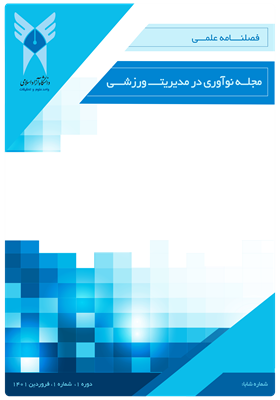بررسی رابطه سواد رسانهای والدین با سواد حرکتی دانشآموزان با توجه به جنسیت دانشآموزان
محورهای موضوعی : نوآوری در مدیریت ورزشی
1 - دانشجوی کارشناسی ارشد - مدیرت رسانه ورزشی، دانشگاه علم فرهنگ، تهران، ایران
کلید واژه: سواد رسانه ای, والدین, سواد حرکتی, کارکرد سواد حرکتی, دانش آموزان دختر و پسر,
چکیده مقاله :
این تحقیق به بررسی رابطه آگاهی و اثربخشی والدین با سواد حرکتی فرزندانشان با توجه به جنسیت فرزندان میپردازد. به این منظور 100 دانشآموز (دختر و پسر) با میانگین سنی 10 تا 15 سال در منطقه شرق تهران بهطور تصادفی انتخاب و از طریق جدول مورگان نمونه تعیین شد. جهت ارزیابی سواد حرکتی شرکتکنندگان از زیر سازههای مدل سواد حرکتی (شایستگی بدنی، آمادگی جسمانی مرتبط با سلامت) استفاده شد. اینگونه که دادههای شایستگی بدنی با استفاده از آزمون رشد حرکتی درشت ویرایش سوم اولریخ جمعآوری خواهد شد. علاوه بر این، از 200 نفر از والدین این دانشآموزان خواسته میشود تا اطلاعات ثبتشده در پرسشنامه فرزندانشان را تائید کنند و همچنین پرسشنامه سواد رسانهای را تکمیل کنند. برای اندازهگیری آمادگی جسمانی مرتبط با سلامت، (ترکیب بدنی) BMI، (آمادگی هوازی) آزمون راه رفتن دویدن 540 متر، (آمادگی عضلانی) دو آزمون دراز و نشست نیمخیز و شنای سوئدی 90 درجه، (انعطافپذیری) آزمون انعطافپذیری بنشین و برسان، مورداستفاده قرار گرفت. همچنین بهمنظور ارزیابی کارکردهای حواس حرکتی از آزمون عصب ـ روانشناختی کانرز استفاده شد. برای آزمون فرضیههای این پژوهش از روش رگرسیون چندگانه ساده و همچنین همبستگی پیرسون و تحلیل واریانس یکراهه با آزمون تعقیبی توکی استفاده شد. سطحمعناداری 05/0 در نظر گرفته شد. نتایج این تحقیق از ارتباط معنیدار و مسقیم بین سواد رسانهای والدین با کارکردهای سواد حرکتی دانش آموزان حکایت دارد، همچنین نشان میدهد که رابطه سواد رسانهای والدین بر میانگین میزان سواد حرکتی دانشآموزان پسر بالاتر از دختران میباشند.
This research examines the relationship between parents' awareness and effectiveness with their children's motor literacy according to the children's gender.For this purpose, 100 students (girls and boys) with an average age of 10 to 15 years were randomly selected in the eastern region of Tehran and the sample was determined through Morgan's table. In order to evaluate the motor literacy of the participants, the sub-structures of the motor literacy model (physical fitness, health-related physical fitness) were used. In this way, physical fitness data will be collected using Ulrich's third edition gross motor development test. In addition, 200 parents of these students are asked to confirm the information recorded in their children's questionnaire and also complete the media literacy questionnaire. To measure health-related physical fitness, (body composition) BMI, (aerobic fitness) 540m run walk test, (muscular fitness) two sit-ups and 90 degree Swedish swim tests, (flexibility) sit-and-reach flexibility test, Was used. Also, in order to evaluate the functions of motor senses, Connors neuropsychological test was used. To test the hypotheses of this research, simple multiple regression method as well as Pearson's correlation and one-way analysis of variance with Tukey's post hoc test were used. A significance level of 0.05 was considered. The results of this research indicate a significant and direct relationship between parents' media literacy and motor literacy functions of students, and also show that the relationship of parents' media literacy on the average level of motor literacy of male students is higher than that of girls.
_||_


